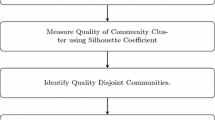Abstract
Community identification refers to the process of selecting dense clusters with sparse connections to the rest of the graph. These communities naturally overlap in many social networks, while each node can participate in several communities. Revealing these structures represents an important task in network analysis. In fact, it allows to understand the features of networks. However, many community detection approaches fail to provide communities with high quality and better ground truth correspondence in reasonable execution time. The key idea of this paper is to propose a coupled-seed expansion method for the overlapping community detection. Specifically, we construct a coupled-seed by choosing a node and its most similar neighbor and then expand this coupled-seed using a fitness function that improves the identification of local communities. The overlapping modularity, the F-score and the extended normalized mutual information measures are used to evaluate the proposed algorithm. The experimental results on 10 instances of real networks and four sets of LFR networks prove that the proposed method is effective and outperforms the existing algorithms (BigClam, OSLOM, SE, Demon, UMSTMO, LC, Ego-Splitting).








Similar content being viewed by others
References
Rosvall M, Bergstrom CT (2008) Maps of random walks on complex networks reveal community structure. Proc Natl Acad Sci 105(4):1118–1123
Clauset A, Newman ME, Moore C (2004) Finding community structure in very large networks. Phys Rev E 70(6):066111
Pons P, Latapy M (2005) Computing communities in large networks using random walks. In: International symposium on computer and information sciences. Springer, pp 284–293
Blondel VD, Guillaume J-L, Lambiotte R, Lefebvre E (2008) Fast unfolding of communities in large networks. J Stat Mech Theory Exp 10:P10008
Newman ME (2004) Detecting community structure in networks. Eur Phys J B 38(2):321–330
Xie J, Kelley S, Szymanski BK (2013) Overlapping community detection in networks: the state-of-the-art and comparative study. ACM Comput Surv (CSUR) 45(4):43
Ahn Y-Y, Bagrow JP, Lehmann S (2010) Link communities reveal multiscale complexity in networks. Nature 466(7307):761
Lancichinetti A, Fortunato S, Kertesz J (2009) Detecting the overlapping and hierarchical community structure in complex networks. New J Phys 11(3):033015
Baumes J, Goldberg MK, Krishnamoorthy MS, Magdon-Ismail M, Preston N (2005) Finding communities by clustering a graph into overlapping subgraphs. IADIS AC 5:97–104
Xie J, Szymanski BK, Liu X (2011) SLPA: Uncovering overlapping communities in social networks via a speaker-listener interaction dynamic process. In: 2011 IEEE 11th international conference on data mining workshops. IEEE, pp 344–349
Lancichinetti A, Radicchi F, Ramasco JJ, Fortunato S (2011) Finding statistically significant communities in networks. PLoS ONE 6(4):e18961
Whang JJ, Gleich DF, Dhillon IS (2013) Overlapping community detection using seed set expansion. In: Proceedings of the 22nd ACM international conference on information & knowledge management. ACM, pp 2099–2108
Coscia M, Rossetti G, Giannotti F, Pedreschi D (2012) Demon: a local-first discovery method for overlapping communities. In: Proceedings of the 18th ACM SIGKDD international conference on Knowledge discovery and data mining. ACM, pp 615–623
Yang J, Leskovec J (2013) Overlapping community detection at scale: a nonnegative matrix factorization approach. In: Proceedings of the sixth ACM international conference on Web search and data mining. ACM, pp 587–596
Asmi K, Lotfi D, El Marraki M (2020) Overlapping community detection based on the union of all maximum spanning trees. Libr Hi Tech
Epasto A, Lattanzi S, Paes Leme R (2017) Ego-splitting framework: from non-overlapping to overlapping clusters. In: Proceedings of the 23rd ACM SIGKDD international conference on knowledge discovery and data mining. ACM, pp 145–154
Chen D, Shang M, Lv Z, Fu Y (2010) Detecting overlapping communities of weighted networks via a local algorithm. Phys A 389(19):4177–4187
Whang JJ, Gleich DF, Dhillon IS (2016) Overlapping community detection using neighborhood-inflated seed expansion. IEEE Trans Knowl Data Eng 28(5):1272–1284
Berahmand K, Bouyer A (2018) LP-LPA: A link influence-based label propagation algorithm for discovering community structures in networks. Int J Mod Phys B 32(06):1850062
Berahmand K, Haghani S, Rostami M, Li Y (2020) A new attributed graph clustering by using label propagation in complex networks. J King Saud Univ-Comput Inf Sci
Dong S (2020) Improved label propagation algorithm for overlapping community detection. Computing 102(10):2185–2198
Berahmand K, Bouyer A, Vasighi M (2018) Community detection in complex networks by detecting and expanding core nodes through extended local similarity of nodes. IEEE Trans Comput Soc Syst 5(4):1021–1033
Lindner G, Staudt CL, Hamann M, Meyerhenke H, Wagner D (2015) Structure-preserving sparsification of social networks. In: 2015 IEEE/ACM international conference on advances in social networks analysis and mining (ASONAM). IEEE, pp 448–454
Shen H, Cheng X, Cai K, Hu M-B (2009) Detect overlapping and hierarchical community structure in networks. Phys A 388(8):1706–1712
Lancichinetti A, Fortunato S (2009) Benchmarks for testing community detection algorithms on directed and weighted graphs with overlapping communities. Phys Rev E 80(1):016118
McDaid AF, Greene D, Hurley N (2011) Normalized mutual information to evaluate overlapping community finding algorithms. arXiv preprint arXiv:1110.2515
Leskovec J, et al. (2010) Stanford network analysis project. http://snap.stanford.edu
Zachary WW (1977) An information flow model for conflict and fission in small groups. J Anthropol Res 33(4):452–473
Lusseau D, Newman ME (2004) Identifying the role that animals play in their social networks. Proc R Soc Lond Ser B Biol Sci 271(6):S477–S481
Tasgin M (2005) Community detection model using genetic algorithm in complex networks and its application in real-life networks. Graduate Program in Computer Engineering
Author information
Authors and Affiliations
Corresponding author
Additional information
Publisher's Note
Springer Nature remains neutral with regard to jurisdictional claims in published maps and institutional affiliations.
Rights and permissions
About this article
Cite this article
Asmi, K., Lotfi, D. & Abarda, A. The greedy coupled-seeds expansion method for the overlapping community detection in social networks. Computing 104, 295–313 (2022). https://doi.org/10.1007/s00607-021-00948-4
Received:
Accepted:
Published:
Issue Date:
DOI: https://doi.org/10.1007/s00607-021-00948-4




